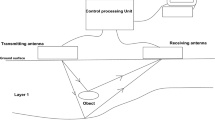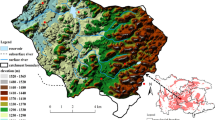Abstract
Reliable and accurate earthwork calculation is one of the most important components in road engineering that can influence the construction cost and road alignment choice. In this research, the method of ground penetrating radar (GPR) was applied to detect the subsoil rock share in forest road construction. The GPR data acquisition was carried out using a 250 MHz GPR antenna along 22 segments on the centerline and 12 meters across to the road project. The GPR data processing was done by performing different filters, such as background removal, migration, band pass filter, and horizontal and vertical smoothing on the GPR data. To investigate the capability of the GPR method used in this road construction project, we compared the GPR radargram and road profile after construction. The results indicated that the maximum penetration depth of the GPR waves produced by a 250 MHz GPR transmitter antenna, which were between 2 and 5 meters in fine area (clayey soil with high moisture content) and rocky grounds, respectively. Moreover, the capability of GPR to map large dimension roots and water content is presented in this work. Comparison of the GPR records with direct observations of road profiles revealed that the GPR technique can yield a wide range of information that leads to a more efficient and effective earthwork operation of forest roads, although in some parts of the road profile the expected results from the target depth of rock share were not achieved.






Similar content being viewed by others
References
Barton N, Lien R, Lunde J (1974) Engineering classification of rock masses for the design of tunnel support. Rock Mech 6:189–236
Bieniawski ZT (1975) Case studies: Prediction of rock mass behaviour by the geomechanics classification, Proc. 2nd Australia-New Zealand Conf, Geomech. Brisbane, Australia, pp 36–41
Butnor JR, Doolittle JA, Kress L, Cohen S, Johnsen KH (2001) Use of ground-penetrating radar to study tree roots in the southeastern United States. Tree Physiol 21:1269–1278. https://doi.org/10.1093/treephs/21.17.1269
Clark M, Gordon MO, Forde M (2004) Issues over high-speed non-invasive monitoring of railway trackbed. NDT E International 37:131–139
Contreras M, Aracena P, Chung W (2012) Improving accuracy in earthwork volume estimation for proposed forest roads using a high-resolution digital elevation model. Croat J For Eng 33:125–142
Cox K, Scherm H, Serman N (2005) Ground-penetrating radar to detect and quantify residual root fragments following peach orchard clearing. HortTechnology 15:600–607
Daniels D (2004) Ground penetrating radar, 2nd edn. the Institution of Electrical Engineers, UK. doi:https://doi.org/10.1049/PBRA015E
Doolittle JA, Collins ME (1995) Use of soil information to determine application of ground-penetrating radar. J Appl Geophys 33:101–108
Doolittle J, Butnor A, John R (2009) Soils, peatlands, and biomonitoring. In: Jol H (ed.) Ground penetrating radar: theory and applications, chap. 6. Elsevier, Amsterdam, pp 179-202
Ékes C, Friele P (2004) Ground penetrating radar and its use in forest road stability analysis. Proc. Tenth International Conference on Ground Penetrating Radar 2:639–642
Ghajar I, Najafi A, Torabi SA, Khamehchiyan M, Boston K (2012) An adaptive network-based fuzzy inference system for rock share estimation in forest road construction. Croat J For Eng 33:313–328
Ghajar I, Najafi A, Karimimajd AM, Boston K, Ali Torabi S (2013) a program for cost estimation of forest road construction using engineer's method. Forest Sci Technol 9:111–117
Goodman RE (1989) Introduction to rock mechanics. Wiley, New York, p 576
Guo L, Chen J, Cui X, Fan B, Lin H (2013) Application of ground penetrating radar for coarse root detection and quantification: a review. Plant soil 362:1–23
Harrison RB, Adams AB, Licata C, Flaming B, Wagoner GL, Carpenter P, Vance ED (2003) Quantifying deep-soil and coarse-soil fractions. Soil Sci Soc Am J 67:1602–1606
Hirano Y, Dannoura M, Aono K, Igarashi T, Ishii M, Yamase K, Makita N, Kanazawa Y (2009) Limiting factors in the detection of tree roots using ground-penetrating radar. Plant Soil 319:15–24
Hoek E, Bray JW (1981) Rock slope engineering. The Institution of Mining and Metalurgy, London, p 358
Inaba S, Heinimann HR, Shiba M (2001) A model to estimate rock excavation volume of forest roads in steep terrain conditions. In: Proceedings of the 112th Meeting of the Japanese Forestry Society. Japan, 2–4 April
Jain S (1986) some interesting conclusions from a study of Q-attenuation. J Can Soc Explor Geohys 22:17–32
Jol MH (2009) Ground penetrating radar: theory and applications. Elsevier, Amsterdam
Jung G, Jung J, Cho SM, Suh J, Rhee J, Kim H (2004) Evaluation of road settlements on soft ground from GPR investigations. Proc. Tenth International Conference on Ground Penetrating Radar 1 and 2. pp 651–654
Knodel K, Lange G, Voigt HJ (2007) Environmental geology Handbook of field methods and case studies. Springer, Berlin, pp 853–861
Koppenjan S (2009) Ground penetrating radar systems and design. In: Theory and applications, ground penetrating radar. Elsevier, Amsterdam, pp 73–97
Liu YC, Chen CS (2007) A new approach for application of rock mass classification on rock slope stability assessment. Eng Geol 89:129–143
Lorenzo H, Perez-Gracia V, Novo A, Armesto J (2010) Forestry applications of ground-penetrating radar. Forest Syst 19:5–17
MALA° G (2014) ProEx – Professional Explorer Control Unit. Operating manual v. 2.0, pp 1–60
Prokhorenko V, Ivashchuk V, Korsun S, Musiyachenko S, Borodavka V (2012) Topographic correction of GPR profile based on odometer and inclinometer data. In: Ground Penetrating Radar (GPR), 2012 14th International Conference on. IEEE, June, pp 425-429.
Sensors and Software (1999) Win_EKKO User’s Guide. p.Version 1.0
Simeoni MA, Galloway PD, O'Neil AJ, Gilkes RJ (2009) A procedure for mapping the depth to the texture contrast horizon of duplex soils in south-western Australia using ground penetrating radar, GPS and kriging. Soil Res 47:613–621
Smith DG, Jol HM (1995) Ground penetrating radar: antenna frequencies and maximum probable depths of penetration in quaternary sediments. J Appl Geophys 33:93–100
Stover DB, Day FP, Butnor JR, Drake BG (2007) Effect of elevated CO2 on coarse-root biomass in Florida scrub detected by ground-penetrating radar. Ecology 88:1328–1334
Stückelberger JA, Heinimann HR, Burlet EC (2006) Modeling spatial variability in the life-cycle costs of low-volume forest roads. Eur J For Res 125:377–390
Tanikawa T, Hirano Y, Dannoura M, Yamase K, Aono K, Ishii M, Igarashi T, Ikeno H, Kanazawa Y (2013) Root orientation can affect detection accuracy of ground-penetrating radar. Plant soil 373:317–327
Valerio G, Galli A, Barone PM, Lauro SE, Mattei E, Pettinelli E (2012) GPR detectability of rocks in a Martian-like shallow subsoil: a numerical approach. Planet Space Sci 62:31–40
Wickham GE, Tiedemann H, Skinner EH (1972) Support determination based on geologic predictions. Proc. 1st Rapid Exc Tun Conf. AIME, New York, pp 43–64
Author information
Authors and Affiliations
Corresponding author
Rights and permissions
About this article
Cite this article
Pazhouhan, I., Najafi, A., KamkarRouhani, A. et al. Subsurface elements prediction for the design of forest road using ground penetrating radar technique. Bull Eng Geol Environ 78, 753–761 (2019). https://doi.org/10.1007/s10064-017-1180-7
Received:
Accepted:
Published:
Issue Date:
DOI: https://doi.org/10.1007/s10064-017-1180-7




